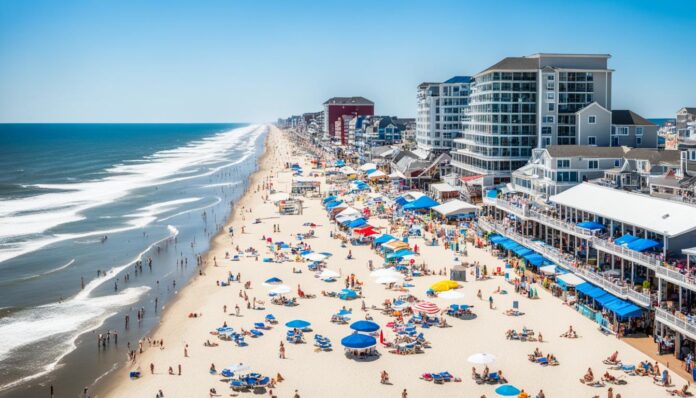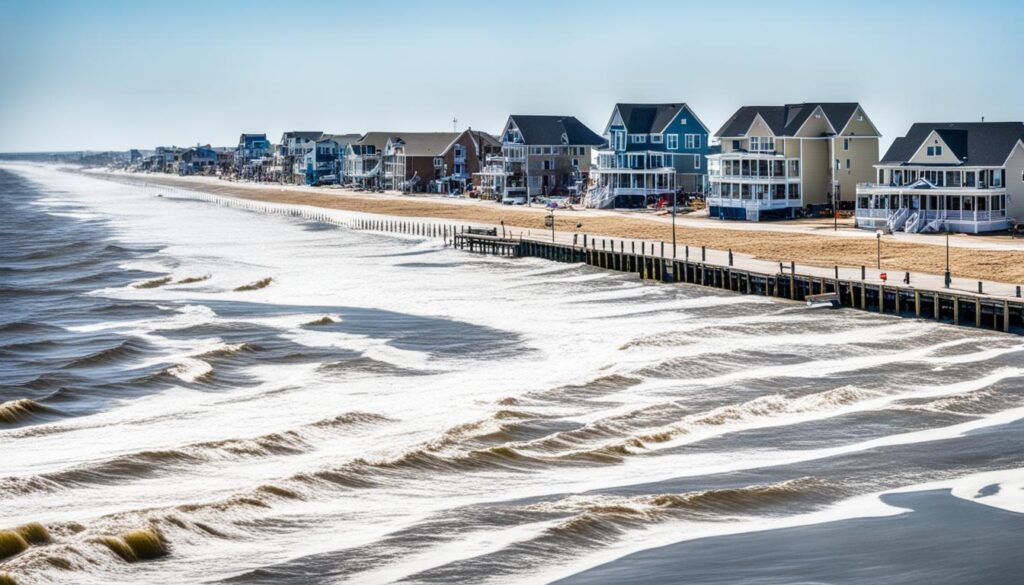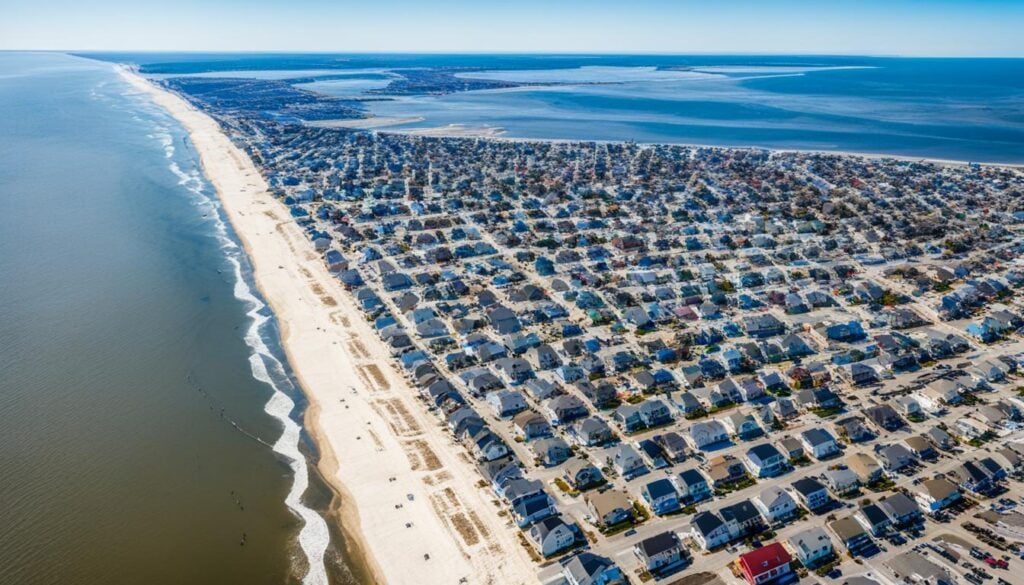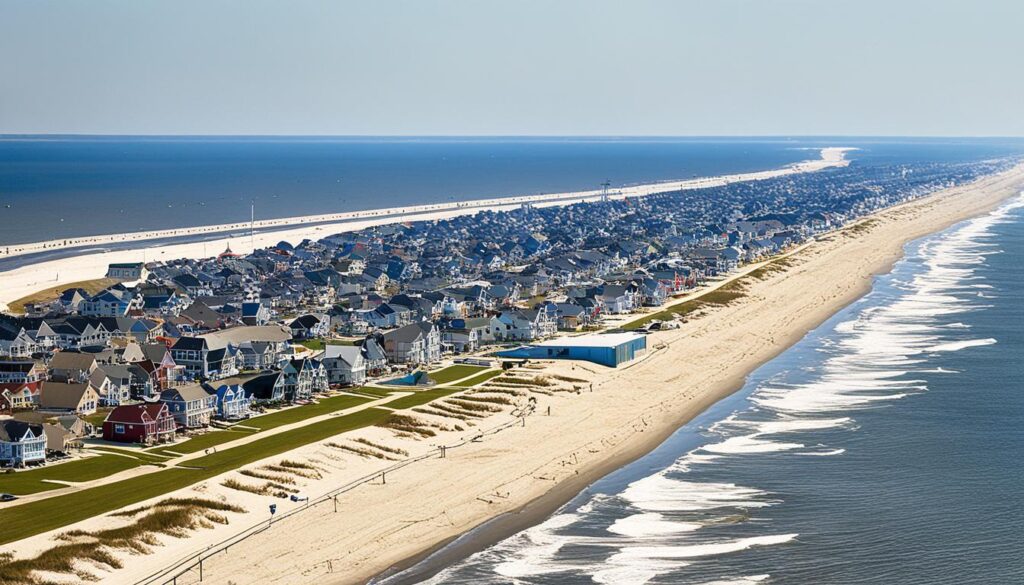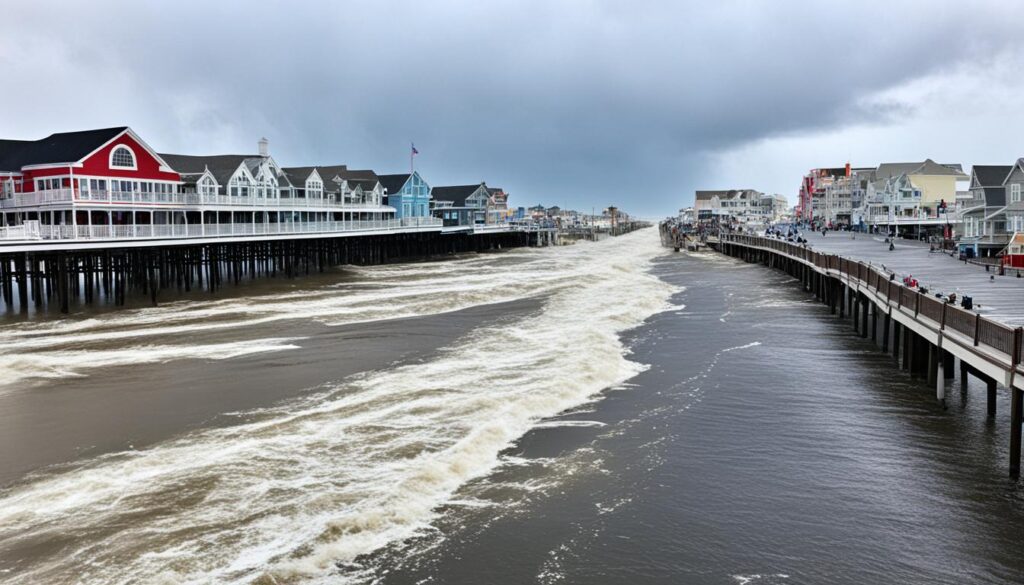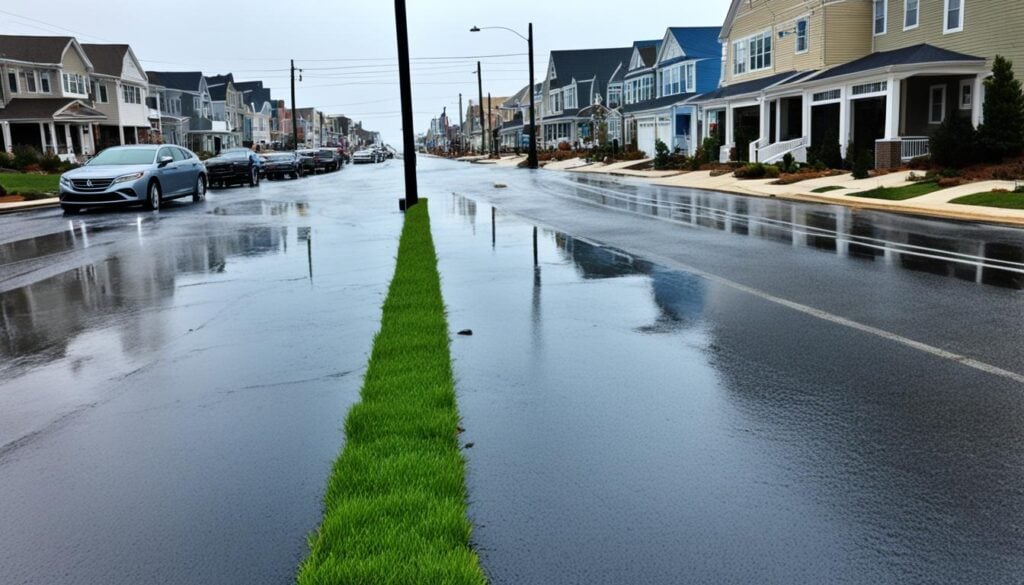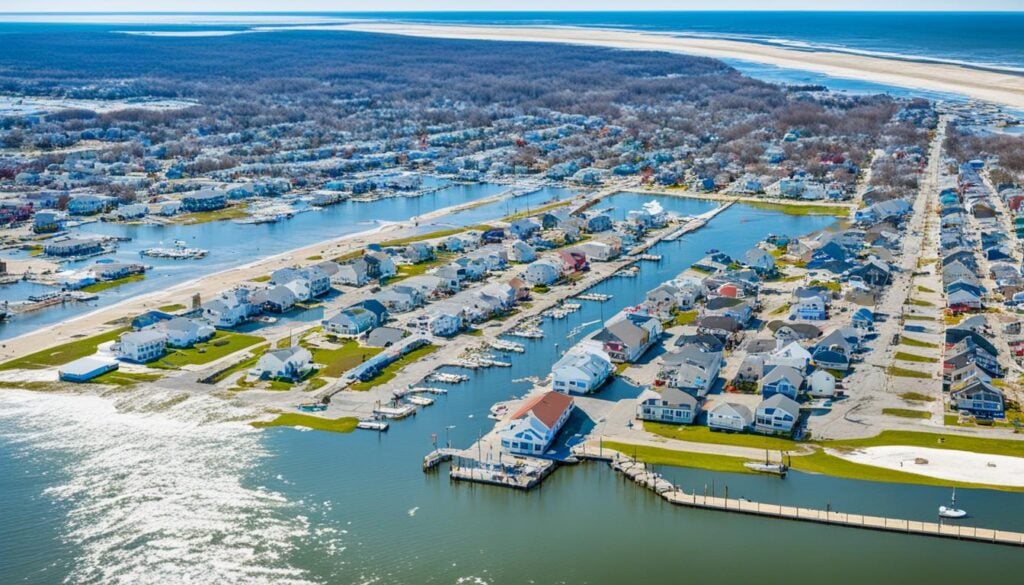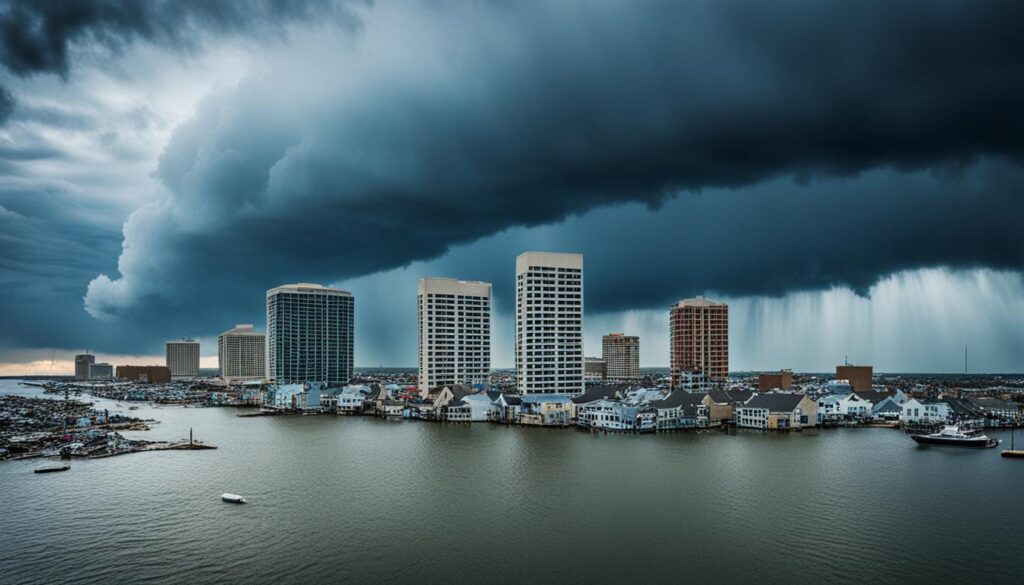Ocean City faces a big question: How to protect its future from rising sea levels and floods? The city has a detailed plan. It includes Coastline Adaptation, Coastal Management, and Flood Mitigation.
This plan is unique because it combines science and community efforts. Ocean City is acting now to fight climate change’s effects. It wants to keep its economy, nature, and people safe. You’ll see how this city plans to overcome the challenges of sea level rise.
Understanding the Challenges of Sea Levels in Ocean City
Ocean City faces big challenges from rising sea levels. These challenges make flooding risks higher, threatening buildings and nature. The constant flooding changes the environment in big ways.
Local businesses and tourism suffer a lot from these problems. If flooding gets worse, more tourists might not come. This makes keeping everyone safe a top priority for the authorities.
It’s important to know what makes Ocean City vulnerable. Coastal erosion is a big worry, as it could erase the area’s beauty. Quick action is needed to save Ocean City’s beauty and economy.
How does Ocean City address rising sea levels and coastal flooding?
Ocean City is now facing big challenges from rising sea levels and coastal flooding. These problems affect local communities a lot, causing economic and environmental issues. Ocean City is working hard to deal with these problems to protect its people.
The impact of rising sea levels on local communities
Rising sea levels bring many problems. Local communities pay more taxes for better infrastructure. Property gets damaged more often, which hurts businesses and homes. Also, people might have to leave their homes because of the rising water.
Key statistics highlighting the urgency
It’s important to understand the urgency of this issue. The statistics show that sea levels could go up by three feet by 2100. Flooding is happening more often, which means we need to act fast. Here are some key statistics:
| Year | Projected Sea Level Rise (in feet) | Flooding Incidents per Year |
|---|---|---|
| 2020 | 1.1 | 15 |
| 2030 | 1.5 | 20 |
| 2040 | 2.0 | 30 |
| 2050 | 2.5 | 40 |
| 2100 | 3.0 | Over 60 |
Ocean City Coastal Management Strategies
Ocean City uses a mix of vision and action for effective coastal management. It focuses on sustainable planning that looks at land use and the environment. This approach helps protect the coast and support community growth.
Integrated approaches to coastal planning
Integrated coastal planning helps us see how nature and human activities interact. Ocean City balances development with nature protection by managing things like zoning and recreation. This way, we get:
- Enhanced community resilience to climate impacts.
- Improved water quality through better land-use practices.
- Preservation of habitats vital for local wildlife.
Collaborations with environmental agencies
Ocean City works with agencies to improve its coastal management. This teamwork shares knowledge and resources, helping follow ecological rules. It shows a strong effort to protect the coast and grow the economy.
| Collaboration Partner | Focus Area | Benefits |
|---|---|---|
| U.S. Army Corps of Engineers | Flood control and prevention | Advanced engineering techniques |
| National Oceanic and Atmospheric Administration | Climate research and forecasting | Data-driven decision making |
| Maryland Department of Natural Resources | Habitat restoration | Sustaining biodiversity |
Ocean City Flood Mitigation Efforts
Ocean City has started many projects to fight flood risks. The city wants to improve its infrastructure and systems to protect against bad weather. This work involves local authorities, experts, and the community, showing how important it is to be ready for floods.
Recent initiatives and projects
Important projects include building new drainage systems and putting in advanced flood barriers. These steps help Ocean City reduce flooding and make sure the community can act fast in emergencies. Some key projects are:
- New stormwater management systems designed to handle increased rainfall.
- Creation of flood zones and assessment areas to better understand vulnerabilities.
- Upgrades to existing infrastructure, such as roads and public facilities, to withstand flooding.
Community engagement in flood preparedness
Your help is key to keeping Ocean City safe from floods. The city has many programs that encourage you to be part of your safety plan. These programs teach you about the risks and how to get ready. Important ways to get involved include:
- Workshops that provide training on emergency response and evacuation procedures.
- Distribution of flood preparedness materials, including emergency kits and local resources.
- Establishing local committees focused on flood risk assessment and management.
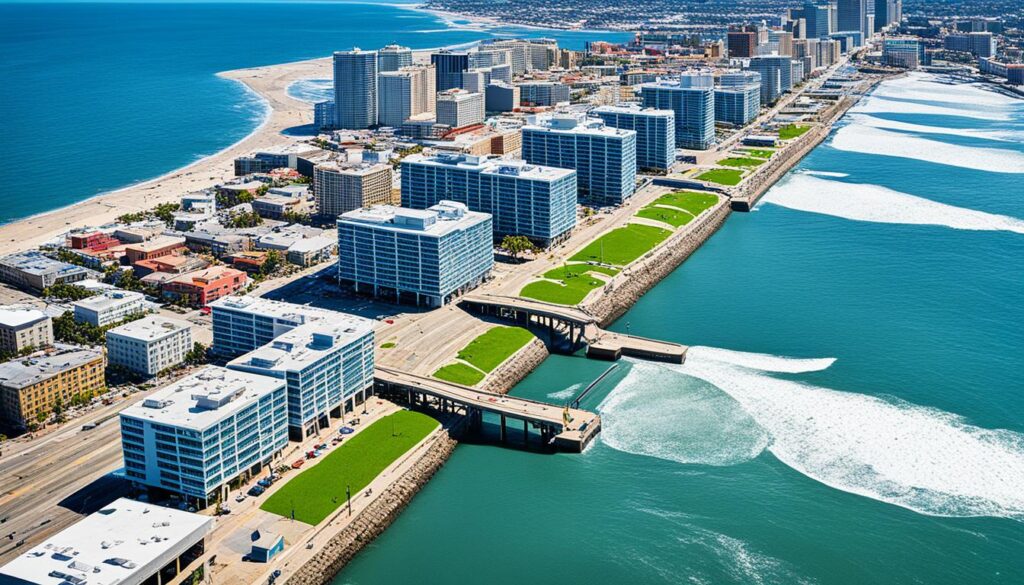
| Project | Description | Status |
|---|---|---|
| Stormwater System Upgrade | Improved drainage systems to handle heavy rainfall. | Completed |
| Flood Barrier Installation | Construction of barriers to protect vulnerable areas. | Ongoing |
| Community Workshops | Training sessions to educate residents on preparedness. | Scheduled |
Ocean City Climate Resilience Initiatives
Ocean City is working hard on long-term plans to tackle climate change challenges. These plans aim to tackle current threats and prepare for future ones. They focus on strategies that can adapt to new challenges.
Developing long-term resilience plans
For effective climate resilience, we need to think ahead. Long-term plans help spot community weaknesses, support sustainability, and use resources well. They focus on proactive steps like building strong infrastructure and community projects.
Case studies of successful resilience programs
Looking at successful programs gives us great ideas. Ocean City has set up several initiatives that show how other towns can do it right. These programs work with local people to make sure efforts meet community needs. For example:
- Coastal Restoration Projects: These have cut down erosion and made natural barriers stronger against floods.
- Community Education Workshops: Teaching people about climate resilience has gotten more locals involved in green efforts.
- Green Infrastructure Solutions: Using green roofs and permeable pavements has bettered stormwater management and made the area look nicer.
Ocean City Coastal Infrastructure Planning
Ocean City is working hard to plan for more frequent and severe floods. This is crucial for protecting people and the local economy. Experts in urban planning and engineering are updating the infrastructure to handle floods. They also aim to keep the natural beauty of the area.
Updating infrastructure to withstand flooding
The main aim is to make infrastructure that can stand up to floods. This means making roads, bridges, and stormwater systems stronger. By looking at the latest climate data, they can focus on the most vulnerable areas and use new ways to fight floods.
Innovative designs and technologies used
For Ocean City’s coastal planning, new technologies are being used. These include:
- Seawalls that lessen the impact of waves and protect homes by the water.
- Levees act as barriers to keep floodwaters away from homes.
- Smart drainage systems watch stormwater and help manage it better.
- Permeable pavements help recharge groundwater and stop flooding.
These new tools help Ocean City fight the rise in flooding. Keeping up with infrastructure updates is key to keeping the city safe and accessible. It also helps keep Ocean City’s charm alive.
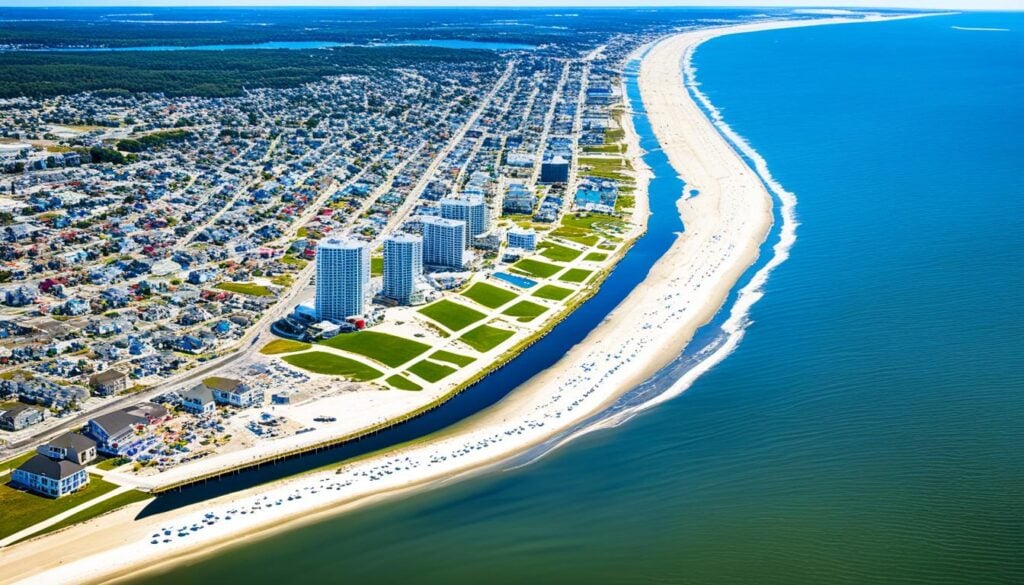
Ocean City Stormwater Management Practices
Understanding how to manage stormwater is key for keeping Ocean City safe and healthy. By using advanced solutions, we can lower flood risks and improve water quality. This shows how green infrastructure is vital for planning cities in a sustainable way.
Techniques for effective stormwater drainage
Ocean City uses many techniques to manage stormwater well. These include:
- Bioswales: These are natural features that help control stormwater runoff.
- Permeable pavements: These surfaces let water soak in, cutting down on runoff.
- Rain gardens: These are planted areas that catch and absorb rainwater.
These methods are key to Ocean City’s stormwater management. They help handle excess water, protecting ecosystems and buildings.
Benefits of green infrastructure
Using green infrastructure in stormwater management has many perks. The main advantages are:
- Less flooding: It reduces runoff, stopping it from overloading drainage systems.
- More wildlife: It creates homes for plants and animals in cities.
- Better looks: It makes neighborhoods prettier with natural elements.
- Cleaner water: It filters out pollutants, making water safer for everyone.
These benefits make for a cleaner, greener place for everyone. By supporting these practices, you help make cities better for the future.
Public Awareness and Education Campaigns
Improving Ocean City’s resilience depends a lot on public awareness and education. These efforts teach people about the dangers of flooding. By sharing important information, the community can get ready for emergencies better.
Informing residents about flooding risks
Ocean City has many ways to educate people about flooding risks. Regular meetings share updates and tips on how to prepare for floods. Experts talk about the latest research and how to stay safe.
Workshops and community engagement efforts
Community workshops are key for bringing people together. They focus on flood safety and how to be prepared. Through fun activities and talks, everyone learns more about flooding risks and how to help.
Ocean City’s public awareness campaigns make sure everyone knows what to do. They aim to make every resident feel ready and able to act.
Future Outlook and Challenges Ahead
Ocean City is facing big challenges with rising sea levels and more flooding. It’s important to understand these issues to plan well. This helps with making good decisions for the future.
Potential obstacles in implementation
Getting enough money for long-term projects is a big hurdle for Ocean City. Not having enough funds can slow down important work. Working with different groups can also be tough because everyone might have different ideas.
Long-term projections for sea level rise
The future looks worrying for Ocean City with sea levels expected to rise. Without action, floods could get worse, affecting buildings, nature, and people. It’s crucial for everyone to work together to protect Ocean City’s future.
Conclusion
Ocean City’s flood strategy shows a deep understanding of the need for coastal resilience. Throughout this article, we’ve seen how the city is tackling flooding risks. It’s clear that the community plays a big part in these efforts.
There’s a big focus on planning for the future. This planning helps build a sustainable and ready community. By working together, Ocean City is making progress in managing floods. These efforts are vital for now and for the future of the community.
The city’s commitment to coastal resilience is strong. Ocean City is working to protect its environment and future with a focus on the community and new ideas. This dedication to improving flood resilience will help keep the city thriving for years to come.

































